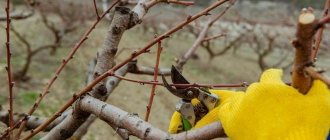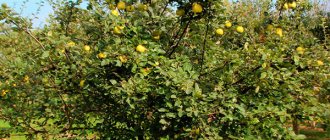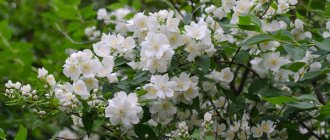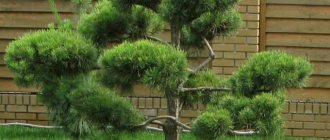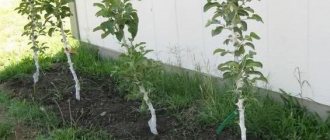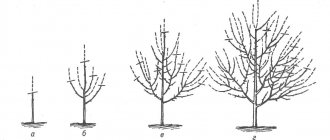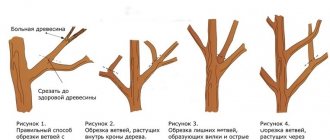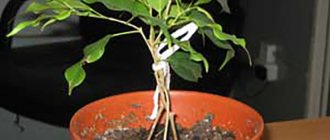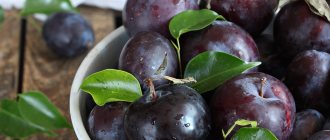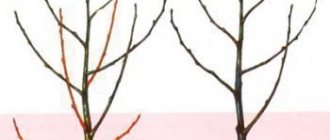Home Country garden
If you are already familiar with the basic rules for shaping and pruning fruit trees, it’s time to become more familiar with how to perform these agricultural techniques. These include: a cut for a bud, a ring and a transfer. You also need to know how to properly prune fruit trees if the branches grow at an acute angle, and how to trim tops (powerful, vertically directed shoots).
- 2 Correct pruning of fruit trees into a ring (with video)
- 3 How to properly prune a fruit tree if the branches are at an acute angle (with photo)
- 4 How to properly prune fruit trees for transfer yourself
- 5 Removing large branches from fruit trees
- 6 How to properly prune fruit trees in spring (with video)
- 7 Pruning tops of fruit trees for fruiting
- 8 How to properly prune fruit trees and form a crown (with video)
- 9 Pinching fruit trees and bending branches
- 10 Kerbovka and ringing of fruit trees (with video)
- 11 Pruning fruit trees to improve fruiting
Pruning fruit trees in the garden: cut to bud (with photo)
Pruning fruit trees in the garden in the photo
Before properly pruning fruit trees, we carefully look at the annual growth and select a bud that faces in the desired direction. Where the bud is directed is where the shoot that will develop from it will grow in the next season; in the future it may become a large branch. We hold the pruner slightly inclined, so that the lower edge of the cut is at the level of the base of the bud, and the upper edge is at the level of its tip. (If you hold the pruning shears differently, it can be argued that the bud will be seriously damaged.) The cutting blade is located on the side of the bud that is being left, and the supporting blade is on the side of the part of the branch that is being removed. The cross-section turns out not to be a circle, but an ellipse. When pruning fruit trees, we make the cut in one decisive movement.
The first common mistake is that the cut is made too high and the stump is too large. It will still dry out at least to the nearest kidney, and if pathogens get into the wound, the process can quickly go further.
Proper pruning of fruit trees into buds is a delicate job. Consequently, the quality of the tool and the sharpening of its blades is of particular importance. This directly determines how quickly the cut will grow.
The second common mistake is making the cut too low. The bud is damaged, or at least the vascular bundles that branch from the stem and go to the bud. Transport flows are disrupted, with a high probability the bud will die, and after it, the area of the shoot located below.
These photos show how to properly prune fruit trees into buds:
Shortening
Bud cut
The cut should be oblique and start strictly opposite the base of the bud facing the desired direction, and end 2–3 mm above its apex.
Kidney cut. Photo: Nina Belyavskaya
We use pruning shears
It is very important to learn how to hold the pruning shears correctly. The photographs show the process through the eyes of the cutter himself (right-handed). Pay attention not only to the cut lines, but also to the location of the blades. Practice on the training branches, constantly monitoring yourself and checking the picture until you get used to it. When making a cut with pruning shears, you need to use your second hand, if possible, to slightly press the branch towards the counter-cutting part of the pruning shears. Then the wood does not pinch the blade so much and cuts much easier.
Transfer to a side branch. Photo: Nina Belyavskaya
Transfer to side branch
The cut is made just above the base of the branch that is left, so that the cut plane looks like its logical continuation. You cannot cut the “foundation” of the remaining branch, nor leave a stump of the cut part. The cut should also be slightly inclined in the direction opposite to the preserved branch.
Correct pruning of fruit trees into rings (with video)
Pruning fruit trees into a ring in the photo
With further growth and development, the boundaries of the growths are erased, but with a little practice you will learn to see the ring growths (photo)
To prune fruit trees as carefully as possible, you need to clearly understand where the rings are on the branch. At the base of each year's growth (the bud ring is formed by scars of fallen bud scales). On young branches, the bud rings are clearly visible; the current year's growths usually have brighter and more shiny bark. With further growth and development, the boundaries of the increments are erased, but with a little practice you will learn to see the annular nodules (“bark folds”). It is in the annular influx that the wound meristem arises. Wood and bark are formed from the wound meristem and heal the wound at a rate of about 1 cm per year.
If the branch is thin, take a pruner. We position it with the working blade facing us. We hold the branch to be removed with the other hand and slightly move it away from us - with tension it is easier to make the cut. We cut it. The manufacturer has already taken care that the blades of the pruning shears are adjusted correctly and the cut is made where it is needed - it will protrude slightly to the touch. This is right. When pruning fruit trees in the garden, do not try to make a flush cut, as in carpentry and construction work. It’s beautiful - yes, it’s possible, but the cut will take longer to overgrow, and the big question is whether it will overgrow - you’ve removed the annular influx “with meat”. We also do not leave stumps; if necessary, we trim the cut with a garden knife.
If the thickness of the branch is such that you doubt that you can handle it using pruning shears, take a hacksaw (I repeat, especially for the stronger sex - a hacksaw, not a chainsaw). Branches have a habit of breaking off suddenly, leaving long-healing scuff marks in the bark. To prevent this from happening, we always start working with a hacksaw from the bottom up. We find the ring bead, try it on and start sawing. We saw as much as possible, hold the branch to be removed with your free hand and slightly move it away from you and slightly upward so that the hacksaw blade does not get pinched in the cut (you will certainly feel it if this happens).
Then we move on to the second action - we start sawing from top to bottom - again along the annular bead. Hold the branch being sawed off with your free hand. Ideally, the cuts converge and form a single smooth cut. In practice, this does not always happen, so if necessary, we level the cut surface with a garden knife. Be sure to cover the cut with garden pitch or similar compounds.
Watch a video of pruning fruit trees into rings:
How to properly prune a fruit tree if the branches are at an acute angle (with photo)
How to properly trim the branches of fruit trees if they grow at an acute angle? Usually, in a situation where a branch branches off at an acute angle, the annular influx is poorly expressed. You'll have to remember your school geometry lessons to find the cut line (you can use chalk, charcoal, a marker or a bar of soap and make a drawing directly on the bark). In many cases, this is also the most convenient line to work with.
- Draw a line parallel to the branch that remains.
- Draw a line perpendicular to the branch to be removed.
- Find the bisector of the resulting angle. This is the optimal cutting line.
- We make the cut, starting to work with a hacksaw from the bottom.
- We complete the cut with a cut from the top, trim if necessary and be sure to seal it.
Sharp corners in the crown are very dangerous - these are potential places for unexpected and serious faults. Cracks can appear at any moment, and they take a long and painful time to heal. Risk factors include high yields, heavy rain and wind, or even snow that often accumulates in forks.
Of course, such a serious defect as an acute angle needs to be corrected as early as possible.
Often in mature trees it is no longer possible to eliminate this deficiency without causing large wounds. In this case, a decision is often made to leave the branch - on the principle of choosing the lesser of two evils.
These photos demonstrate how to prune fruit trees if the branches are branching off at a sharp angle:
Trimming roses into a ring. How to trim to a ring, to an external or internal bud
In some cases, pruning fruit trees is the only way to revive, rejuvenate or even save a tree, so every gardener should know the technique of pruning.
Unfortunately, many beginners and not-so-beginners summer residents do not attach much importance to the “correctness” of making a cut. What wisdom can there be here, I cut it down and cut it down. However, pruning done anyhow often does not benefit the tree, but, on the contrary, weakens it, negates disease resistance, and reduces yield.
Let's learn how to trim branches correctly!
So, in practice, two main types of pruning are used. These are ring pruning and bud pruning. These are exactly what we will talk about today.
Ring trimming
This pruning method is used in situations where you need to cut out a fairly large tree branch entirely. For example, a dried, broken, non-fruiting or weak branch.
If you look closely at the branch, you will notice a peculiar ring-shaped influx on the bark at its base. This influx contains cells capable of rapid reproduction. Thanks to such cells, wounds from a hacksaw or pruning shears heal faster. Therefore, you need to cut the branch along the upper edge of this very ring.
First, the branch (especially if it is large or located at an awkward angle) is cut down with a garden hacksaw from the bottom to about a third of the thickness, retreating from the ring by 25-30 centimeters. Then, moving the hacksaw to the side by 2-3 centimeters, they cut from above. After removing the branch, the stump is sawed off along the top of the ring.
If the cut turns out to be uneven or torn, be sure to clean it up with a knife, because a smooth cut heals much faster.
All saw cuts are treated with brilliant green for disinfection (it works even better), and then they must be covered with special paint.
You cannot cut down a branch above the ring, leaving a stump. You cannot cut a branch together with a ring. Such errors when pruning cause cavities, cracking of wood, rotting or drying out of the branch. A weakened branch is a green light for pests and pathogens of various diseases, especially fungi. And there’s nothing to say about the harvest.
But what to do if the ring is clearly not visible, but the branch needs to be cut? In this case, it is recommended to mentally draw a line along the branch from which the one to be removed grows, and another line - perpendicular to the branch to be removed at its base. The resulting angle should be divided in half. The bisector will be the direction of the cut.
Pruning “to the bud”: internal and external
Bud pruning is performed to shorten branches to encourage branching.
This method is often used for shrubs and some fruit trees. If the plant has a thickened center and it is necessary to expand and thin out the crown, prune “to the outer bud.” This means that the branch is shortened to an outward-facing bud, directed from the center outward.
When the plant is too spreading, when you need to raise the lower branches and strengthen the center, pruning is required “to the inner bud,” that is, the one that is directed towards the center of the crown.
Here, as with ring pruning, it is very important to make the correct cut. The cut should be oblique, no higher than half a centimeter from the bud. A stump that is too high will interfere with wound healing, and a low cut can damage the kidney.
If you notice that the wood inside the cut is dark and brown, it means the branch has already begun to die. It is shortened to healthy (light) wood or removed entirely.
Do not forget to cover all cuts with paint made specifically for quick healing of cuts (for example, “Garden Luck”). Many gardeners cover tree wounds with garden varnish. But organic farming experts, on the contrary, do not recommend garden varnish, because it does not allow air to reach the branch and slows down healing.
After pruning, all branches must be removed away from the tree or bush and burned. In this way, all pests and pathogens will be destroyed, and we will receive an excellent organic fertilizer - ash.
We wish you success and great harvests!
How to properly prune fruit trees for transfer yourself
Quite often it is necessary to remove not the entire branch, but only part of it. Again, this cannot be done in an arbitrary place. Transfer pruning is a method of removing excess part of a branch. Using pruners and a hacksaw, we transfer the growth of the branch to strong branches growing in the direction we need, and remove the excess.
To properly prune fruit trees yourself, as professionals advise, you need to select a strong side branch on a large branch growing in the desired direction, and remove everything that is higher than this branch. The difference from cutting a branch into a ring is that the cut is made so that its plane is a continuation of the branch being left.
In most cases, they are transferred to a branch directed outward. If the crown is spreading, then it is usually transferred to a branch growing vertically or slightly inside the crown. Drooping branches (typical of apple tree varieties such as Autumn Striped, or Streifling, Pepin saffron) are transferred to horizontal or slightly upward branches.
Basic pruning techniques
Fruit trees, with the crown formed correctly, consist of a central trunk (also called a conductor), and large skeletal branches that branch into smaller shoots. Each part of the tree needs sufficient light and oxygen, which is why annual pruning of the garden is carried out.
Pruning scheme: selecting branches to remove
Fruit tree branches should not cross, cover each other, or intertwine. All shoots that grow at the roots or near the trunk (the lower part of the conductor without skeletal branches) take up nutrients and therefore must be removed.
Removing large branches from fruit trees
If the branch to be removed is large and thick - as thick as a spade handle or more - then it is wiser and safer to remove it in parts. You will have to make several cuts, but this will save both people and the tree from injury, and in the end it will be less labor intensive, although it will take a little more time.
The branches only seem light and airy, but in fact their weight can reach several tens of kilograms. As usual, to avoid scuffing the bark, we always start sawing from the bottom.
First we need to shorten the branch. We choose an arbitrary place where it is convenient for you to work, and make a cut from below - approximately half the diameter of the branch. Then we retreat 4-5 cm closer to the trunk and make a second cut - from above. And then the laws of physics begin to work - the branch neatly breaks off along the lines of the cuts and the longitudinal line connecting them under its own weight, only in rare cases does it have to be helped by a slight movement of the hand.
If necessary, repeat the combination of two cuts on the next section of the branch. And finally - the last cut. We carry it out as usual - almost always a large branch is cut out for a ring, less often for a transfer.
The photo of pruning fruit trees shows how to remove large branches:
How to properly prune fruit trees in spring (with video)
If the winter was frosty and/or snowless, and there is a possibility that the tree was damaged, do not rush into spring pruning of fruit trees, as they tend to “heal wounds.” The tree, invisible to the human eye, will strive to restore everything that can be restored, and first of all this concerns educational and conductive tissues. Therefore, after harsh winters, buds often bloom two weeks or even a month later, when the tree’s conducting system begins to function normally again.
After a harsh winter, pruning of fruit trees in the spring is carried out only after the buds have fully bloomed, and only for sanitary purposes. The tree needs to spend its energy sparingly, it has no need to heal additional wounds, and any other types of pruning can greatly weaken it and reduce its vitality, but the excess and dead must be removed. It is likely that some of the branches will begin to bud, but then they will dry out - this is also normal, the tree itself listens to itself and decides what is more important for it to save. There is nothing wrong with postponing planned formative, rejuvenating or restorative pruning to the next season.
In the most difficult cases, when the scale of damage is large, you will have to limit yourself to sanitary pruning for several years. However, damaged trees tend to produce a lot of tops, and you can usually start working with them, forming future fruit-bearing branches from them.
Watch the video “Spring pruning of fruit trees” to better understand how this agricultural technique is performed:
Useful tips and subtleties of pruning trees and shrubs
There are different ways to prune a garden. With their help you can influence the plant and achieve the desired result. Using various techniques, you can stimulate the active growth of branches in the desired direction, or limit it by enhancing branching, flowering, and fruiting. All these methods are most effective during the formation of the crown of a young tree.
Growth limitation
On each process there is the uppermost bud (apical). Its presence indicates that the shoot will actively grow in length.
How to limit branch growth by pruning
If you cut off the top, growth stops and side shoots begin to develop. If you remove the apical buds on the lateral growths, active branching will begin.
Direction, strength of growth
If the growths are located vertically on the branch, their development will be more intensive than those that are directed horizontally. Depending on how the bud is located on the branch, you can determine the direction of growth of the future shoot.
A way to influence the direction and strength of growth
Eyes looking straight up or at an acute angle from the vertical will ensure strong growth. The lower the bud deviates from the vertical shoot, the more growth force slows down to a medium and weak level. An eye pointing downwards indicates that there will be virtually no shoot growth.
Shortening the escape
When the shoot is shortened almost at the very base, strong lateral growths will develop from the remaining buds. If the branch is trimmed slightly, the sprouts will be less developed. Weak shortening is aimed at more active branching.
Scheme of weak and strong shortening of shoots
Choosing a cutting location
Garden pruning “on the bud” is used during the formation of the crown of young trees. The number of lateral growths and the intensity of their growth depend on the number of buds left on the shoot. If the plant is mature, it is necessary to carry out rejuvenating pruning on perennial branches to stimulate the growth of young shoots.
Determining where to cut the branch to a bud
Pruning tops of fruit trees for fruiting
Pruning fruit trees for fruiting in the photo
Tops are powerful, vertically directed shoots that grow from dormant buds on old wood, usually in mid-summer. The number of tops per unit length of a branch largely depends on the variety, but can also be a signal of trouble - the tree shows that it is sick with something, or this is a reaction to incorrect or too strong pruning, in particular, to an incorrect reduction in crown height. A large number of tops is a biological feature of the pear.
Tops grow quickly, with a “wolfish appetite”, and in a season they can reach 1.5 m or more, while also branching.
Since they are directed vertically, their main task is growth, and fruiting from these strong and powerful branches will have to wait several years. In nature, thus, the tree rejuvenates, new branches grow, and the old ones gradually die off - especially since they literally find themselves in the shadow of the tops.
In most cases, the tops greatly thicken the crown, and since they also extend at very sharp angles, they must be decisively removed to a ring. In the first couple of weeks of growth, trimming the tops is not necessary, since they can easily be broken off with your fingers, and a small wound will quickly heal. In the future, to trim the tops for fruiting, you will need pruning shears and even a hacksaw.
However, there are cases when it is advisable to leave the tops. For example, if the tree is already at an “advanced” age, and you plan to remove an old branch, and there is a strong and well-placed top nearby, then you can grow a replacement branch from it. Only for this it is necessary to limit the growth of the top in height. To do this, you need to either trim the tops of fruit trees for transfer, or bend them to give them a position close to horizontal in order to stimulate the laying of fruit formations. In subsequent years, with a high probability, the “cultivated” top will produce new shoots directed vertically - you will have to do the same with them.
In case of severe damage, the tops are the “starting material” for a new crown. If a top has formed next to a large cut, it makes sense to leave it for a year, but be sure to pinch the top - the top draws in nutrients and works as a “pump,” which speeds up the healing of the wound.
Schemes for pruning pear, cherry, apple and other trees
Pruning trees in the spring is a guarantee that in the summer there will be a beautiful and blooming garden; for beginners, a step-by-step diagram of the entire procedure is provided in pictures. You can see this in more detail in the video.
To do this, remove the following:
- branches growing at an acute angle;
- shoots directed inward;
- empty branches that do not bear fruit.
Experienced gardeners advise following certain rules:
- The process must be started immediately after severe frosts have subsided, so that by the time the juices begin to flow, the wounds will already have healed.
- The branches above the eyes growing inside the crown are trimmed.
- The branches, which seem to be a continuation of the trunk, should be longer than the others.
- If the tree is very weak, then short pruning is performed above the second or third eye.
- If the tree grows strongly, then perform medium pruning and remove shoots above the fifth eye.
- If the tree is very elongated, then carry out a long pruning, cutting off the branches above the eighth eye.
A video has been specially prepared for beginners, where the pruning process is shown in detail.
Let's look at the general principles of pruning an apple tree, starting from the root, which is clearly visible in the pictures step by step:
- remove young shoots from the trunk;
- cut off branches that look down;
- cut off branches growing very close to each other;
- we remove shoots that look down;
- we eliminate branches facing the trunk;
- we cut off the branches that cross each other;
- shorten the top of the tree.
In the pictures, the entire process of pruning trees in spring is depicted step by step, this diagram is especially useful for beginning gardeners.
When pruning cherries, there are some nuances:
- We remove all weak shoots from a still young seedling;
- we leave only 5-7 strong branches facing in different directions, while the gap between them should be about 10 cm;
- The central shoot, to be at the same time, is 20 cm longer than the others.
The process of pruning cherries can only be carried out in the spring.
The pear pruning scheme goes as follows:
- if after winter frosts tops appear on the tree, that is, empty branches that will not bear fruit, then they must be removed or shortened;
- It is necessary to carry out moderate pruning so as not to weaken the tree;
- branches that are a year or more old need to be slightly shortened, this will make them stronger.
The pictures show the whole process step by step more clearly.
How to properly prune fruit trees and form a crown (with video)
In some cases, especially in the case of trees on vigorous rootstocks, it is necessary to limit the size of the crown. More often it is necessary to limit the height of the crown, less often the diameter. A common mistake is to prune fruit trees flush with the ground, like trimming a hedge. The result is disappointing and even frightening. Remember the Greek myth about Hercules and the Lernaean Hydra, whose severed head grew two new ones? Roughly the same thing happens with improperly pruned trees, only more than two heads usually grow, and even on each cut.
When pruning and shaping fruit trees, gardeners limit the height of the crown for several reasons, the main of which are the difficulties of care, pruning and harvesting, and the tree itself spends too much effort on “delivering” nutrients - young, active functioning, roots and shoots.
Reducing the crown height during the formation of fruit trees is carried out strictly for translation. The cut is made above a well-placed branch that you decide to leave. In essence, reducing the height of the crown is the same as pruning for transfer, only it is not the side branch that is cut out, but the top.
If a particular variety is prone to the formation of a large number of tops, then after the crown height decreases, the tree will try with redoubled force to take up the lost volume. In this case, a “trick of war” will help: pruning is divided into two seasons. In the first year, the crown is reduced - but slightly higher than the planned height. The tree will produce a lot of tops, and here you need to be patient (shortening the tops to limit their growth is not prohibited). In the second year, the crown is lowered at the planned height, and the entire top, overgrown with tops, is removed with one cut. In the future, the tree usually “calms down” and begins to grow at the size you specified, and only sometimes you will have to remove single tops.
Here you can watch a video on how to properly prune fruit trees to form a beautiful crown:
Pear pruning
When to prune a pear
Beginners in gardening believe that pruning a pear tree is no different from pruning an apple tree, but this is not entirely true. We will tell you about when and how to prune a pear, and you can do a comparative analysis yourself. Pear trees, like apple trees, are not recommended to be pruned every year.
Autumn sanitary pruning of pears is permissible as long as the temperature outside is above zero, but if frosts unexpectedly hit, then pruning must be postponed until spring - trees cannot be pruned in cold weather, since the wounds remaining after pruning not only do not heal, but also lead to freezing of the branches, which is why they die. It is best to prune a pear in the spring, when the air temperature warms up to 8 ºC.
However, if there is a need to do this in the fall, then pruning in September is quite acceptable, but not later. The most convenient crown shape for harvesting is pyramidal, and this must be taken into account when formative pruning of pears.
In the photo: Pears on a tree
Pruning pears in autumn
The formation of the crown of pear trees begins already in the first year of life: it is very important to determine the skeletal branches immediately, so that in the future the crown develops correctly and symmetrically. Annual seedlings are cut at a height of 40-50 cm from the ground
In two-year-old trees that have already acquired 6-8 lateral branches, select 3-4 of them as skeletal branches and prune them at the same level. The conductor is cut 20 cm higher than the skeletal branches.
Pruning older trees in the fall primarily serves sanitary purposes: removing branches that thicken the crown, diseased branches, and those damaged during the fruiting period. It also doesn’t hurt to shorten the annual shoots by a third of the length, and even the crown if the pear is stretching upward too much - this will strengthen the tree, enhance its branching and serve as an impetus for enhanced bud development. However, when pruning, try not to disturb the pyramidal shape of the crown. After completing the procedure, treat cuts and damaged bark with garden varnish: on old, dry branches immediately, and on young, green branches only after a day.
To prune to rejuvenate an old pear, you need to start by shortening its top, but if you have been conscientiously pruning the tree from year to year, and the height of the crown corresponds to optimal indicators, then proceed to thinning it: remove dry, old, non-fruiting branches, cut out shoots , growing at an acute angle or parallel to the trunk, and shorten the remaining shoots by a quarter of the length. Treat all sections with garden varnish or drying oil paint.
To be fair, it should be said that rejuvenating pruning of old pear branches is less painful for the plant in the spring, when the air temperature reaches 5 ºC, but the buds have not yet woken up.
Pinching fruit trees and bending branches
Special techniques are an alternative or complement to pruning. They are not difficult to complete, but you will need to know thoroughly what you want to get in the end, and have “three-dimensional thinking”, see the crown in volume - the one that is, and the one that will ultimately be. And, as in the case of pruning, if in doubt, it is better not to do it.
Pinching, also known as pinching, is the removal of the top of a growing young shoot—the annual growth. This is done when the shoot is still green, and the top is easily broken off with your fingers - in the place where you decided to limit the growth of the shoot. Usually they pinch off above the third to fifth true leaf, when the length of the shoot is about 1-5 cm. The optimal time for pinching is when there are 2-3 weeks left before the end of shoot growth, in the middle zone this is approximately mid-July. A completely similar action is performed when shaping tomatoes, cucumbers and some houseplants - so it is quite possible that you are already familiar with this technique.
It happens that after pinching the axillary buds begin to grow. If the shoots growing from them are short, these are future overgrowing branches, do not touch them, but long shoots must be pinched again.
If in some place of the tree there is a strong bud from which a branch will develop, but in this place the branch is not needed, then the bud can be blinded - plucked out with your fingers along with the weaker dormant buds located at the base. Do not injure the bark; it is better to blind the dormant buds when they begin to grow.
Thus, you can level the emerging crown of a young tree or use these techniques when forming artificial crown forms. Due to the size of mature trees, these techniques are of limited use.
Growing tops can be broken out with your hands or a stick with a hook (even a hook available on the farm will do) - since the growth processes are still ongoing, the wound will quickly heal. It is easiest to break out the tops when they do not exceed 1-5 cm in length; then it is better to use pruning shears, since the likelihood of scuffing the bark increases. Tops are easily recognized by their vertical growth and lighter and often larger foliage. After removing the tops, sometimes new tops develop from dormant buds in the same place - they will also have to be removed.
If the tree is still young, then it has few branches and, accordingly, leaves. Working hard with pruners will deprive the tree of foliage, and, consequently, reduce the area for photosynthesis and worsen nutrition. Therefore, it makes sense to cut out unnecessary branches of a young tree in parts, and at first only limit their growth. In addition, the branches coming from the trunk contribute to the formation of a trunk that gradually expands downward, which increases the mechanical strength and stability of the tree.
Bending back branches of fruit trees is an alternative to removing branches in some cases. If only a branch directed at an ugly angle is looking in the right direction, you can try to correct the situation. If the angle of departure of the branch from the trunk is very sharp, then it is better not to risk it and cut the branch - with a high probability it will simply break and not bend back. The branch is fixed at the desired angle for one or two seasons. If you bend back the branches at the end of growth, when lignification begins, then one season is usually enough.
The fastening must be free, with allowance for thickening of the branch, so soft material must be placed under the ropes and wires - for example, pieces of rubber. Please note that over the course of a season, the branch increases in diameter by about a centimeter, and a tightly tightened rope bites into the bark and can literally strangle the branch in one season. It is better to remove all fastenings for the winter and put them back in the spring.
If the branch is still young and flexible, but remains thick, then in the lower part of the bend you can make several parallel cuts about a third of the diameter - this will help bend the branch, and the wounds will quickly heal. Thick branches that have lost their elasticity cannot be bent. It should be taken into account that if the limb turns out to be “humpbacked”, then in the upper part of the “hump” there will be the best conditions for feeding the buds, and it is here that strong and powerful vertically directed tops will grow. In some cases, this is advisable - you grow a strong shoot in the part of the crown where it is necessary, and then remove part of the “mother” branch by pruning for transfer - to a young and strong shoot.
The meaning and advantages of autumn pear pruning
Many novice gardeners refuse to trim young and mature pear trees for fear of harm. Others believe that the larger a fruit tree grows, the greater the chances of reaping a good harvest from it. However, this is fundamentally wrong. An overgrown crown prevents sunlight from reaching the fruits, which negatively affects their juiciness and taste. In addition, by leaving old dry branches, you risk that they will damage healthy ones by breaking off in winter under the weight of snow.
The value of pruning also depends on the age of the pear. For young trees that have not yet entered the fruiting season, it is important to correctly form the skeleton and crown. Those already bearing fruit need to be helped to distribute nutrients in order to achieve a better harvest. But for old trees, the need for rejuvenation comes first.
Pruning of pear crowns is most often carried out in spring and autumn. The benefits of autumn pruning are as follows:
- The growing season has been completed, which means that no new shoots will form on the cut this year.
- The sap flow is slowed down, so the juice will not flow out through the cut wounds.
- Proper autumn pruning of pears and the formation of a sparse crown stimulate fruiting in the next season.
- More opportunities to carry out work without haste and risk to the tree. Spring can come quickly, and you may not have time to complete the work before the sap begins to flow. Or, conversely, after early pruning, frost may occur, which will interfere with wound healing. But autumn pruning can be done at any time after the fruits are harvested. The main thing is to complete it 2-3 weeks before the first frost.
Autumn pruning of pear seedlings is not performed in the year of planting. This can stunt the growth of a young tree and reduce its chances of successfully overwintering. In all other cases, the procedure is recommended to be carried out annually or at least every other year.
Kerbovka and ringing of fruit trees (with video)
Take a closer look at the annual growths - in which direction the bud is facing, the shoot will be directed there next season. If in this particular place you want to get a strong - or, conversely, weak - branch, then you can use kerbovka.
Kerbovka of fruit trees is carried out in early spring, before the buds begin to swell. Take a garden knife and select a bud or twig. All that needs to be done is to carefully cut the bark along with part of the wood in two arc-shaped movements so that a “crescent” is formed, which we remove from the cut. If a bud or twig needs to be strengthened, then the “crescent” forms a “surprisedly raised eyebrow” on top. Thus, we block the ascending transport flows of the xylem and do not allow them to reach the upstream buds, and the bud we have chosen receives better nutrition. If a “crescent” is made under the bud, resembling a smile from ear to ear, then it will weaken the future branch and limit its growth.
You can see how fruit trees are harvested in the video below:
Ginging fruit trees has a similar effect. To do this, a narrow strip of bark is removed. Attention! The strip of bark, contrary to the name of this technique, should not pass in a ring, but in a spiral, or in two half-rings with a small gap - thus, traffic flows will be pinched and not completely blocked. A complete ring of bark will disrupt the functioning of the conductive system, and everything above the ring will dry out quite quickly - it’s easier, faster and more humane to cut the branch with pruning shears. The wound must be covered with garden varnish or wrapped in film to prevent drying out.
Banding should not be done on the trunk and skeletal branches, so as not to weaken the tree. It is not advisable to perform ringing on pear and stone fruit crops, as well as weakened apple trees - it will do more harm than good.
Both in the case of kerbovka and in the case of ringing, a narrow strip of removed bark will grow back quite quickly. Fruit girdle is a more dacha alternative to girdling. It can be made from a strip of soft metal with jagged cutouts along the top and bottom edges - this will prevent the metal from cutting into the bark as the branch thickens. The fruiting belt is placed on the branch and secured with wire - it pinches the bark and impedes the outflow of photosynthesis products. The fruit belt can be removed at any time, and this is its advantage over ringing.
The video of ringing fruit trees shows how this agrotechnical technique is performed:
Sometimes the growth in thickness occurs so intensely that the bark cannot stand it and bursts. To prevent this from happening, furrowing of the bark is used - in the spring, with a sharp garden knife, several furrows are applied, running parallel to the branch, 1-2 mm deep - during the season, not a trace will remain of them.
Trimming to stump.
Trimming a stump is not a regular procedure, but a one-time one. When your barberry or mock orange, chokeberry or viburnum, hawthorn or spirea become completely old, their leaves become shredded and the bases of the trunks become bald, flowering becomes sparse, and fruits stop appearing at all - do a drastic pruning.
Shrubs and trees can be trimmed to stumps in late autumn or early spring, before sap flow begins, as soon as it is possible to approach the plant.
But when choosing the timing, think about whether it is worth pruning robins and willows with twisting trunks or colored shoots of derains in the fall. After all, even frozen branches will decorate the winter garden.
You should not experiment with newly planted plants. Trees and shrubs with an unformed root system will not shoot powerful and strong shoots. They may even die.
Only those plants whose roots have already grown sufficiently and have taken root at the planting site can be trimmed onto a stump. Large cuts, for example when rejuvenating old trees, are treated with garden putty to avoid stem rot - it is best to use German putty; they are superior in quality to traditional garden putty.
Old plants are usually weakened and may not respond to the operation with vigorous growth of shoots. Therefore, in order not to lose them completely, try to break the procedure into stages. Divide the total number of shoots in the bush into three parts. The first year, cut out only the first third. It is better if these are the oldest branches. And they should be cut not from one side of the bush, but as evenly as possible. The next year, cut off the second third of the branches. On the third - the remaining old branches. Two-year-old shoots (from the stumps of the year before) will already branch out, new ones will grow from the stumps of last year - as a result, all this time the plant will remain in place, but will be completely renewed.
Such procedures must be combined with fertilizing to give the young growing shoots additional strength.
Pruning fruit trees to improve fruiting
To “persuade” a lazy branch to please you with fruits, there are several ways.
The first is to limit height growth by pruning fruit trees for fruiting, shortening a branch to a bud or branch directed in the desired direction.
The second way is to bend the branch (it is not at all necessary, and often undesirable, to a horizontal position, but at a minimum, the position of the branch must be made vertical). To do this, you don’t have to resort to pruning fruit trees to improve fruiting, but use stretchers - they should secure the branch in the desired position, but not injure the bark. You can hang a weight on a branch - our ancestors “threatened” non-fruit-bearing trees by hanging an ax or various heavy objects in the crown in order to “disgrace” the lazy tree (and they always added verbal intimidation in the style of “if there are no fruits, I will cut them down!”). The branches assumed a more horizontal position, due to which the balance of plant hormones changed and fruiting accelerated.
But if the whole tree is “lazy,” then it makes sense to first check how correctly you are caring for it, and also turn to reference books: perhaps you just have one of the old varieties, which are characterized by a late onset of fruiting. Thus, modern early-fruiting varieties of apple trees begin to bear fruit at 5-6 years, and such popular ancient varieties as Grushovka and Belyi Naliv produce their first fruits at the age of 10-12 and even 15 years, being already large trees. In such cases, pruning is needed to form a beautiful and regular crown, but it will not speed up fruiting.
On the other hand, if it is necessary to stimulate the growth of a specific branch of a young tree, it is “pulled” to the trunk or large branch located above.
This video shows the correct pruning of fruit trees to improve fruiting:
- Author: admin
Rate this article:
- 5
- 4
- 3
- 2
- 1
(5 votes, average: 1.8 out of 5)
Share with your friends!
Why prune fruit trees?
When pruning trees correctly and annually, it is necessary to ensure that each leaf blade is in the sun for at least half a day. Since a leaf growing in the shade produces 10 times less glucose than a leaf located in the sun, this affects the development of the plant as a whole. In addition, a leaf located in the shade dries out more slowly after rain and is more susceptible to various pests and diseases.
Most often they resort to a sparse-tiered method of crown formation. With this method of formation, it is recommended to leave no more than 3-4 skeletal branches in one tier of a tree.
